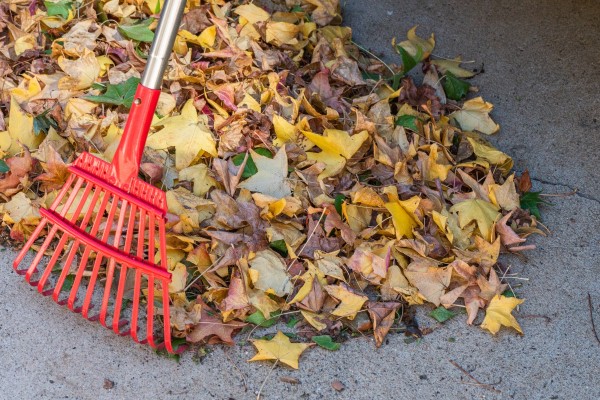As fall sets in, it seems like everyone is racing outside to start raking and tidying up their yards. While a pristine lawn seems to be the standard, it may not always be the best option for the environment. Here are a few tips to make your fall cleanup just a little more eco-friendly this year!

Avoid Leaf Blowers
Leaf blowers are super convenient! They can clear a driveway buried in leaves in virtually no time at all. Unfortunately, they come with some serious drawbacks.
Most leaf blowers are gas-powered, and most aren’t very efficient. In fact, it’s estimated that the typical leaf blower burns 60% of its fuel, emitting the other 40% into the atmosphere. That’s a lot of waste. They also emit nitrous oxide, an aggressive greenhouse gas.2
Leaf blowers are incredibly loud and can cause some serious hearing loss. Always remember to use proper hearing protection while you’re using your gas-powered gadgets and gizmos around the yard.2
If you’re limited physically, a leaf blower might still be the better option. If not, a broom can be a great alternative with significantly lower footprint. While it may take a few extra minutes and a bit of elbow grease, a quick sweep will get the job done just as well.

Provide Habitat
While leaf litter isn’t the prettiest thing in the world, it provides valuable habitat for local critters! According to “Nature’s Best Hope” by Doug Tallamy, 90% of caterpillars and moths pupate on or under leaf matter.3 That’s a lot of pollinators! Leaf litter also provides important winter habitat for insects, creating a safe space for them to spend the cooler months.4 So, if you don’t mind a more rustic look, leave some leaf litter in place for your little neighbors.

Restore Nutrients
Throughout the summer, trees spend large amounts of energy and resources creating leaves. To take advantage of all of the nutrients in leaf litter, use them as mulch in the landscaping of your yard. When they break down, they’ll act as fertilizer, enriching your soil for the next growing year.1
If you aren’t into the rustic look, you can also compost your leaf litter! This allows you to make the most of the nutrients that leaf litter has to offer while maintaining your yard’s pristine appearance. Soon, you’ll have lush soil for your next gardening project.1
With a few more tips in your fall cleanup toolkit, you’re ready to get gardening! Leaf management looks different for everyone, so use what fits your preferences. No matter what, small steps towards sustainability make a big difference in the long run!
Sources
- Mannino, Vince, et al. “Don’t Bag It – Leaf Management Plan.” Texas A&M Agrilife Extension, aggie-horticulture.tamu.edu/earthkind/landscape/leaf-management-plan/. Accessed 17 Sept. 2023.
- Nevitt, Mark. “Think Globally on Climate, Act Locally on Leaf Blowers.” Kleinman Center for Energy Policy, October 20, 2023. https://kleinmanenergy.upenn.edu/news-insights/think-globally-on-climate-act-locally-on-leaf-blowers/.
- Tallamy, Douglas W. Nature’s Best Hope: A New Approach to Conservation That Starts in Your Yard. Portland, OR: Timber Press, 2020.
- Thuma, Jessie. “Why You Should Leave the Leaves (and Give Yourself a Break from Yard Work!).” Tufts Pollinator Initiative, 12 Nov. 2019, sites.tufts.edu/pollinators/2019/11/why-you-should-leave-the-leaves-and-give-yourself-a-break-from-yard-work/#:~:text=If%20you%20want%20to%20support,break%20down%20during%20the%20winter.





